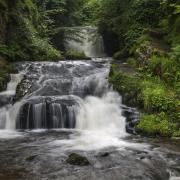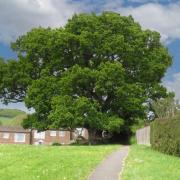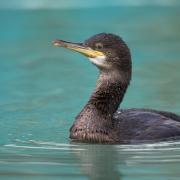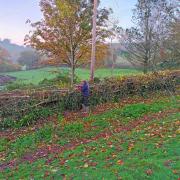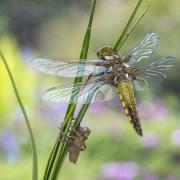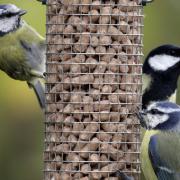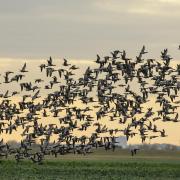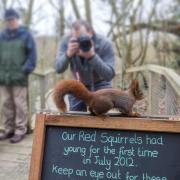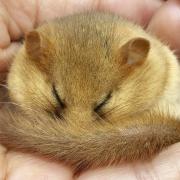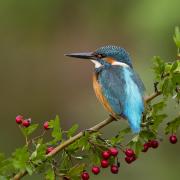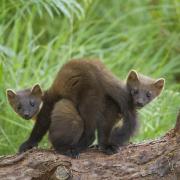Gary Pilkington tells Anna Turns how, even after
23 years at Marsland Reserve, he never gets bored
with his natural surroundings
Otter spraint is another sign of life Gary often sees, but last year he was lucky enough to see otters in broad daylight. “A mother was playing with her two cubs in the stream,” says Gary, who happened to have his video camera to hand at the time. “After I had got over the surprise, I managed to get some great footage. As a naturalist, it’s just nice knowing otters are here on our doorstep.”
Otter spraint is another sign of life Gary often sees, but last year he was lucky enough to see otters in broad daylight
Every season there is something going on, from dormice breeding, to the arrival of migrant birds like the chiff-chaff each spring.
On a smaller scale, the real speciality species of Marsland is the pearl-bordered fritillary. Marsland has become a real stronghold for these endangered butterflies, so Gary often advises other wardens who are trying to achieve similar success. Gary takes me to Hard Hills, a small ten-acre area managed specifically for this species. Just like any butterfly, pearl-bordered fritillaries need areas with grass and flowers to nectar, but they also need a specific breeding habitat and this is what Gary’s team provides.
Understanding the ecology of a species is key to learning what it needs to survive. “When coppicing stopped, the butterfly population plummeted,” says Gary, “so we have reinstated the autumn cutting of bracken on this south-facing slope, which protects the breeding fritillaries and provides insulation for the larvae to develop, and it enables violets to grow, providing vital food for the caterpillars.”
For Gary, Marsland’s success with the pearl-bordered fritillaries is one of his biggest achievements. As he proudly describes: “I’ve yet to find a place in Britain that is as good as this for this species.” Each spring, Gary anxiously waits to see the first pearl-bordered fritillary emerge. “Seeing them return each April is always a thrill.” The adults fly until late May, and Gary tracks their progress. “Sometimes there are just too many to count, and once I just recorded shedloads in my notebook!”
This butterfly spectacle may only last a few weeks, but the management for this species is year round. “When we’re out on Hard Hills working in the snow, you may wonder why we do it! But it is all for that short burst of butterflies.” If Gary’s team stopped coppicing, bracken, willow and gorse trees would grow into woodland, and the life cycle of the pearl-bordered fritillary could no longer continue.
Gary’s passion for the natural world first developed as a child, when he was growing up in Lancashire. “I used to watch David Attenborough’s films, and I loved frogs, newts and anything I could bring home in a jam jar to look at.” Whilst studying English at university, he got his first bird book. “I remember seeing a goldfinch, with that distinctive red face, and wondering what it was. That thrill of correctly identifying something from my bird book got me hooked.”
I love inspiring young children – they are natural naturalists. We need to tap into this and enthuse more teenagers at secondary schools – we’d be sowing the seeds for wildlife enthusiasts of the future
As a boy, he wanted to be a professional footballer. “I never imagined a job like mine would exist.” Gary first trained as a teacher, but then volunteered for the RSPB, and things went from there. “I love being on site so I don’t miss out on seeing what’s happening,” says Gary, who lives in a house in the woods with his wife, Jane. “Marsland has been like a playground for my two children, who grew up here,” describes Gary, who now works with local primary schools. “I love inspiring young children – they are natural naturalists. We need to tap into this and enthuse more teenagers at secondary schools – we’d be sowing the seeds for wildlife enthusiasts of the future.”
At the heart of all of his work is Gary’s determination to conserve the huge biodiversity of Marsland. “Some people ask ‘does it matter if one butterfly species dies out?’ To me that’s a strange question. I’m not religious but I think that all these creatures have evolved alongside us, so they must have some right to be here. Living in a city, wildlife is probably the last thing on your mind – many adults become detached. People enjoy seeing garden flowers and many of us have pets, but we need to reconnect them with an innate need for wildlife.”
To Gary everything is a symbol. “Knowing species are dying out because of human activity can be depressing, but there is a spirituality at a place like Marsland, where you are connected with nature.”
Discover Marsland…
Look out for:• Pearl-bordered fritillaries and small pearl-bordered fritillaries • Dragonflies• Buzzards displaying overhead • Summer arrivals like the blackcap and willow warbler
Visit Marsland: Gary recommends the circular walk down to the sea. Park in the lane at the side of Little Marsland, near Bude, where the path leads down to Marsland Mouth. Detailed directions and visitor information at devonwildlifetrust.org/reserve/Marsland and marslandnaturereserve.moonfruit.com
Become a member: “I would love to protect more wild areas,” says Gary “and becoming a member of DWT is worth every penny.” Join Devon Wildlife Trust at devonwildlifetrust.org or call 01392 279244.
Driving to meet Gary Pilkington at Marsland Reserve, near Hartland, does feel like driving into the back of beyond, but in a wonderful way. “This is a quiet place,” says Gary, when I arrive, “you’re the first car I’ve seen for a few days.” Set in a wooded valley and reaching down to the rugged coastline at Marsland Mouth, this magnificent reserve straddles the Devon-Cornwall border and covers 480 acres.
Gary is now the longest-standing reserve warden at Devon Wildlife Trust
It’s Gary’s passion for the place and its wildlife that brings it to life. “I live my life in these woods, this is my back garden,” he says. Even after 23 years living and working here, he still gets excited about his job and the prospect of another spring season. Gary, Senior Nature Reserves Officerat Marsland, has spent years perfecting his management schemes to make habitats just right for the amazing wildlife living here, in particular a butterfly species called pearl-bordered fritillary.
Gary is now the longest-standing reserve warden at Devon Wildlife Trust (DWT). When he first arrived, he worked alone, but now he is helped by wardens Kate, Simon and Steve, who together also manage other culm grassland sites in North Devon. “The beauty of this place is that it is so quiet – the wildlife is not disturbed,” says Gary. “Marsland remains a wild place but we also take visitor groups round to enjoy it.”
The land was bought by Christopher Cadbury, of chocolate fame, in the 1950s. Gary, 55, first came to Marsland in April 1988 to work for Christopher Cadbury, until he died in 1995. The reserve was taken over by DWT in 1997 but Christopher’s son, James Cadbury, remains involved.
A new office is being built using funds ring-fenced by the Cadbury family to secure Marsland’s future. “We will have our first classroom kitted out with microscopes, a projector and a reference library,” says Gary, “and this will give us a lot more scope for educating groups.” The renovation is being completed with wildlife in mind – holes in thestonework encourage nesting blue tits, and the barn roof has been reconstructed to enable lesser horseshoe bats to breed during the summer.
As we step over winding streams and muddy puddles through the reserve, famous for its butterflies (34 species breed here), Gary points out birdsong from the trees above or animal trails on the ground beneath us. “That’s the call of a nuthatch… and that tree trunk is where badgers cross Marsland stream.” A small bird flits across our view. “Did you see that dipper?” and Gary points out its moss-covered mud nest hanging on the river bank. Then, through the trees, we spot two roe deer.
Everywhere you look, there is activity of some sort. Crossing Goat Meadow, we find feathers and the remains of a wood pigeon. “We have sparrowhawks nesting in the woods and I saw them dive and catch this the other day,” explains Gary.



